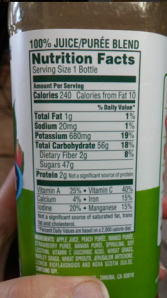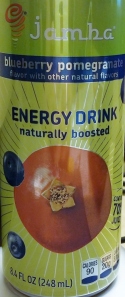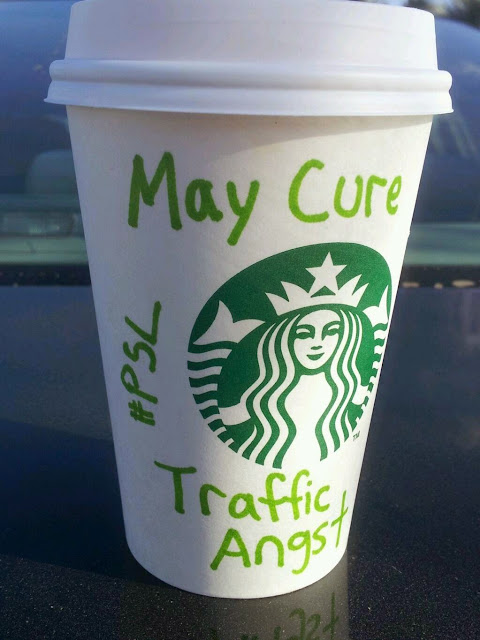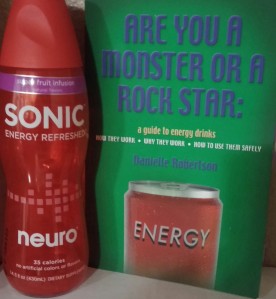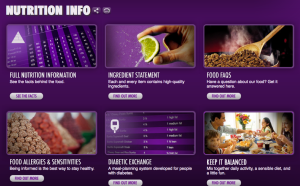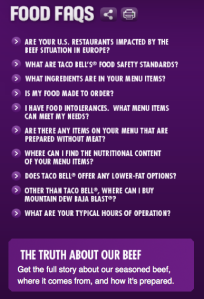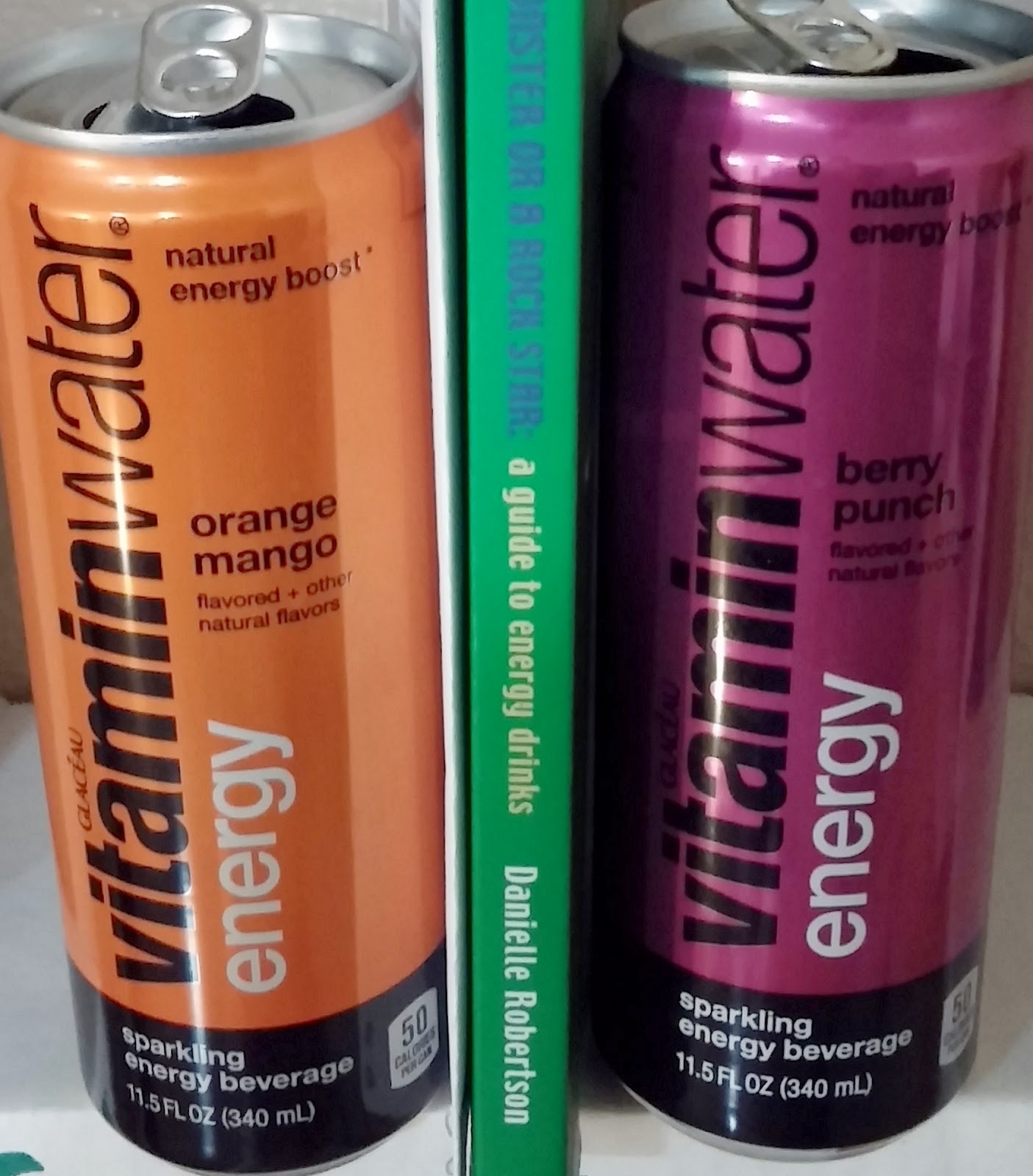Food science in the news, Day-in-the-Life of a Food Scientist, caffeine safety, and the science behind energy drinks and other supplements. From the author of "ARE YOU A MONSTER OR A ROCK STAR: A Guide to Energy Drinks -- How They Work, Why They Work, How to Use Them Safely" -- note this blog has moved to GreenEyedGuide.com
Monday, December 15, 2014
Energy Drink of the Month -- December 2014
The Energy Drink* of the Month for December 2014 is Mio Energy.
*Technically this is not an energy drink, nor is it a shot. Consuming this as-is would be a horrible idea, and is strongly discouraged. Small enough to fit into a purse or a large pocket, this is THE essential holiday tool to help you keep your energy level up through the hustle and bustle of the holiday season. This portability is why Mio wins December. (read more here-->)
Wednesday, December 10, 2014
Quercetin and Lord of the Rings -- An Unexpected Analogy
From Are You a Monster or a Rock Star: A Guide to Energy Drinks -- How They Work, Why They Work, How to Use Them Safely
This is just one of the many analogies and metaphors in the Energy Drink Guide. My philosophy is that nutrition should not be hard to remember. Anything worth remembering should be explained in proper context. If it means nothing to you, you won't remember it and it won't help you in any way later in life. This philosophy may not work for everyone, but it's the philosophy that has always helped me study.
Thursday, November 27, 2014
Green-Eyed Guide's Top 7 Thanksgiving TV Scenes
ONE -- Pardoning a Turkey
C.J. They sent me two turkeys. The most photo-friendly of the two gets a Presidential pardon and a full life at a children’s zoo. The runner-up gets eaten. BARTLET If the Oscars were like that, I’d watch.
| http://youtu.be/fcCgmjqDA7k |
TWO -- Monica Dances with Turkey
| http://youtu.be/hGQCcjp9aiA |
THREE -- Look Behind You
| http://westwing.wikia.com/wiki/The_Indians_in_the_Lobby |
FOUR -- The Butterball Hotline
BARTLET
Stuffing should be stuffed inside the turkey, am I correct?
WOMAN
It can also be baked in the casserole dish.
BARTLET
Well, then we'd have to call it something else, wouldn't we?
This scene is also funny to me because I remember studying the two microbes the Hotline Lady mentions. My response to when first learning about them was pretty much the same as President Bartlet's.
| http://youtu.be/4TcGEcKjSu4?t=1m20s |
FIVE -- Pilgrim Detectives and Butchering the English Language
| http://youtu.be/xsVkCz9MM-Q |
SIX -- Chandler in a Box
| http://youtu.be/Y3mPy-pnYRU?t=1m36s |
SEVEN-- Brad Pitt on Friends
Really I just like this because f the irony of Brad Pitt dissing his then-girlfriend-now-ex Jennifer Anniston. There's a little truth to every joke, right?| http://youtu.be/n8OTYXkHwWk |
Happy Thanksgiving!
Please Like on Facebook
Follow on Twitter
Friday, November 21, 2014
Energy Drink of the Month -- Nov 2014: The NO Edition
4 Caffeinated Products That Put the NO in NOvember
Read more-->
Thursday, November 13, 2014
Naturally Confusing: 2 Things You Need to Know from New York Times Natural Debate
"Would you eat poison ivy or E. coli? Natural does NOT necessarily mean quality." - Food Advocates Communicating Through Science
Is the solution to ban this controversial word from all labels? Probably not, but we should be more concise with the word's implications. FoodInsight.org provides us with perspective:
Naturally Confusing: Two Things You Need to Know from New York Times Natural Debate
Wednesday, November 5, 2014
Food Science in the News - the INFORMATION edition
Food Science in the News - Information is Power
Nutritional Outlook recently posted an article describing the results of a test on different Front of Pack label formats. The International Food Information Council (IFIC) Foundation conducted a study in which they gave consumers four different packages, quizzed them on the nutrient amounts, and asked them which labeling system they preferred. Here were the options, excerpted from the Nutritional Outlook article (full article here):
"The study asked participants to look at four different packages, each featuring a nutrition facts panel as well as a unique FOP label:
1) a control version without any nutrition information on the FOP,
2) an FOP listing calories only,
3) an FOP listing calories plus nutrients to limit, and
4) an FOP listing calories, nutrients to limit, as well as nutrients to encourage.
After looking at these labels, participants were asked to identify the nutrient amounts and percent daily values per serving in each product, rate the ease at which they were able to answer those questions, and pick which product was the best choice nutritionally."
*SPOILER ALERT* the fourth option won. The key here is not just providing the information, but also answering the question, "What am I supposed to do with this information?" Information is almost always useless without context.
If you haven't heard this story yet, give it time. This is just the type of story that mass media loves to jump all over-- a new tool to help consumers with their food choices, combined with the right amount of fear-tactics.
The Environmental Working Group (EWG, not to be confused with Eric Will Gymnastics aka my second home) recently published a food database which contains a scoring system for nutrition, ingredients of concern, and degree of processing. Every product in the database has an overall score, which consumers can use to find "greener, healthier and cleaner food choices." A database like this is a phenomenal tool with the potential to help consumers identify smarter choices for themselves and their families.
HOWEVER, anytime a database involves a rating system, it must also have specific criteria to remove the gray areas for assigning a one score or another. Case in point, how would you rate a vegetable smoothie that has 47g of sugar and contains ingredients with inherently high heavy metal counts (think seaweed) and pathogenic bacterial contamination (think leafy greens and E coli)? What metrics do you use to weight the severity of the "ingredients of concern"? Any ingredient also found in a yoga mat is obviously toxic, but what about salt? Sugar? Caffeine? For the degree of processing ranking, what about raw milk and the dangers associated with it's lack of processing?
I urge you to read the short rebuttal to the EWG ratings system from the Grocery Manufacturers Association (available here). A few of their most crucial points are excerpted below:
“The Environmental Working Group’s food ratings are severely flawed and will only provide consumers with misinformation about the food and beverage products they trust and enjoy. The methodology employed by EWG to develop their new food ratings is void of the scientific rigor and objectivity that should be devoted to any effort to provide consumers with reliable nutrition and food safety information. Their ratings are based almost entirely on assumptions they made about the amount, value, and safety of ingredients in the products they rate. Adding insult to injury, EWG conducted no tests to confirm the validity of any of their assumptions. Not only will the EWG ratings provide consumers with inaccurate and misleading information, they will also falsely alarm and confuse consumers about their product choices. Embedded in the ratings are EWG’s extreme and scientifically unfounded views on everything from low-calorie sweeteners to the nutritional value of organic foods.”
BOTTOM LINE
Information can be empowering, when provided in the right context. Watch out for fear tactics and overly simplified assumptions as to what constitutes "healthy food." As I tell myself every time I do a Risk Assessment for a new ingredient, CONSIDER THE SOURCE. Also, "keep an open mind, but not so open that your brain falls out."I Ate the Whole Thing - Food Label Renovation perspective
FACTS and Fear - how they influence consumer perception
The Dosage Makes the Difference - Lessons from the Father of Toxicology
Help us get to 50 Likes on Facebook! https://www.facebook.com/energydrinkguide
Schedule a 1-on-1 with the GreenEyedGuide on Google Helpouts
Berkeley Passes first US Soda Tax - Food Science in the News
While this could be a good pilot study for the rest of the country, what works for Berkeley may not work for other cities that aren't as notorious for being health-conscious.
Furthermore, it's unfortunate and perhaps short-sighted that Measure D does not apply to 100% fruit juices. I get that we want to encourage fruit (juice?) consumption, but I say if excess sugar consumption is bad for one's health, then all beverages with more than, say, 15g ADDED sugar per 8 ounces should be included in this tax. Note, this is where the Added Sugar Labeling format proposed by the FDA would come in handy.
This is just my opinion. I need to "pull a Hermione" and do some more research on this subject. More to come.
Read the full Nutritional Outlook article here.
Wednesday, October 15, 2014
Energy Drink of the Month -- October 2014
The Energy Drink of the Month for October 2014 is Rockstar Roasted with Almond Milk
Ever since my first exposure to energy drinks (back in 2003), I wanted others to see what I saw, wanted them to know the tips and tricks I know when it comes to reading labels and deciphering the contents of an energy drink. In place of my usual written review for the Energy Drink of the Month, I present this review:| http://youtu.be/2el19xBwyls |
Caffeine in Rockstar Roasted – Caffeine Informer
Rockstar Energy Drink – main site
Five Levels of Fatigue –booklet on Ebay; excerpt from Are You a Monster or a Rock Star: A Guide to Energy Drinks — How They Work, Why They Work, How to Use Them Safely
Energy Drink Guide FACEBOOK PAGE — Help push it to 100 Likes!!!
Sign up for a 1-on-1 with the GreenEyedGuide -- Google Helpouts
Wednesday, October 1, 2014
I am Beachbody - employee recognition
Since I had so much fun making this video, I will share it with the world!
For your viewing pleasure, in case you'd like to be a Food Scientist or Quality Specialist, or just want to know what I do for ~10 hours a day.
I am Beachbody - Who I am and What I Do
I know it's not Jenna Marbles quality, but it's my first video. It's imperfect and it's got character, like myself.
Enjoy!
--Green-Eyed Guide
Saturday, September 13, 2014
Energy Drink of the Month -- September 2014
The Energy Drink of the Month for September 2014 is Jamba Blueberry Pomegranate.
Have
you ever looked at a food or supplement label and thought, "I wish I
knew what the food scientists think about this"? Allow me to present
this opportunity for you to be Mr. Spock or Dr. Xavier (your pick) and read my thoughts as I assess this product.Read the 7 Jamba Observations-->
Wednesday, September 3, 2014
Food Science in the News: Pumpkin Spice Controversy?
I love Pumpkin Spice Lattes. For me that drink is the symbol of Fall. This is especially true since I live in Southern California and there are few other signs the season has changed.
Apparently there's some angst over how Pumpkin Spice lattes aren't made from real pumpkin. If this surprises you or even if you don't care and nothing will affect your love for PSL, check out this article:
In Defense of the Pumpkin Spice Latte
My favorite part:
Kantha Shelke, a food scientist with a background in organic chemistry and spokesperson for the Institute of Food Technologists, gets questions like this all the time. “This conversation about chemicals in food requires a certain amount of responsibility, which I think some of these elitist writers and bloggers and speakers have somehow forgotten,” she says of the backlash against pumpkin spice flavoring. “I think it’s very irresponsible to be ignorant to such a level as to lead others astray and tell them to eat chemical-free food.” After all, she says, water and salt are chemicals."
That said, Pumpkin Spice Lattes (like many things in life) are best enjoyed in moderation.
Thursday, August 21, 2014
The Making of a Quality Professional
| http://www.lmakai.com/commuter-collection-necklace/ |
 |
| http://www.zazzle.com/chemists+have+all+the+solutions+gifts |
Food Science in the News: Carrageenan
Enjoy: Carrageenan in Food
Monday, July 14, 2014
Energy Drink of the Month -- July 2014
 | |
| The Goal |
To commemorate the 1 year anniversary of what I still consider my first child, I'd like to take a look back at a year's worth of posts about the Energy Drink of the Month. Each of them is highlighted for a different reason and almost none of them matches the typical energy drink you'd hear lambasted on the news.
Read More-->
Response to CSPI's Call for Energy Drink Warning Letters - Energy Drinks in the News
That article can be read here: Food Navigator -USA article
At the time of this post, a comment I had posted was removed. That comment is shown below:
Dear CSPI, I get that you want to protect people but if energy drinks aren't proven as the cause of death, how is regulating energy drinks supposed to help? Do you want the FDA to go after every energy drink that contains more than X milligrams of caffeine per container? If so, that won't help those who consume multiple servings of a mild energy drink, or those who mix energy drinks with alcohol. Moreover, without defining the specifics of the problematic energy drinks, you group products like FRS Healthy Energy (38mg caffeine per 11oz can) right alongside products like Redline (375 mg caffeine per 8 oz can). Personally I favor education over regulation, and I'd like to see as much energy (pun intended) go into label reading and consumer education as the fervor that goes into pushing for new regulations.
-Author of "Are You a Monster or a Rock Star: A Guide to Energy Drinks -- How They Work, Why They Work, How to Use Them Safely"
Monday, June 30, 2014
Fear and FACTS -- How both influence consumer perception of food
This insightful observation comes from Food Business News' Executive Editor Keith Nunes. There's no denying that fear is an effective sales strategy. Unfortunately, as Mr. Nunes points out, using fear creates false impressions and confusion among consumers, and these scare tactics are hurting the food and beverage industry. The solution? Fight fear with facts.
Food Science in the News -- Fear and FACTS
In his editorial (found here--page 9), Mr. Nunes mentions several examples of how marketers use subliminal hints to sway consumer perceptions towards certain products by besmirching another. One example in the article is the ketchup label that reads "No HFCS", which taps into consumer fears and public perception more than scientific evidence about HFCS. This is just one example. Have you ever looked at the label of a frozen yogurt product and found that it contains more sugar and fat than the ice cream you passed up? Have you ever indulged in a Vegan cookie because you thought it would be healthier than the non-vegan variety? (like this one -- see #5) Did you know that certified Organic foods are not inherently safer or more nutritious than their conventional counterparts?
With conflicting messages and confusing labels, it's no wonder consumers are puzzled about food science and nutrition. As a food scientist, I try to help my friends and loved ones sort the facts from the fallacies. Granted, I don't always know the answer and I'm not afraid to say so, but sometimes I am afraid to reveal my position. Recently, I discovered an organization which aims to facilitate these types of conversations. Their mission is my mission, so I'm elated to spread the word about the work they are doing.
Introducing the International Food Information Council (IFIC):
Their mission and vision says it all:
 |
| http://www.foodinsight.org/about |
NEW -- the FACTS network:
| http://www.foodinsight.org/FACTS |
The FACTS network is a product of IFIC. This network is like the Caffeine Informer of food: presenting unbiased, science-driven information so all consumers can make informed decisions in pursuit of healthier lives.
3 Reasons Why the IFIC and the FACTS Network Deserve Your Attention
REASON ONE: Daytime Doctors -- John Oliver, Dr Oz and the Unfortunate State of the Supplement Industry
REASON TWO: Public Misconceptions -- Jimmy Kimmel asks Gluten-freebies "What is Gluten?"
REASON THREE: Emotional Conversations -- Raw versus Pasteurized milk; GMOs; Raising a child on a raw food diet; the soda ban; the dangers of energy drinks... These are all conversations that can be difficult to have without emotion. Plenty of scientists avoid these conversations altogether to avoid the confrontation. The IFIC says the percentage of emotional conversations around food is decreasing, but is that because people are learning it's better to avoid these topics or because consumers are becoming more open-minded to different view points? I can only hope it's the latter.
 |
| http://www.foodinsight.org/newsletters/taking-pulse-america%E2%80%99s-diet-findings-2014-ific-foundation-food-health-survey |
For valuable consumer information on raw milk, biotechnology, food labeling, food fortification and other health/nutrition topics, explore the IFIC website: http://www.foodinsight.org/
Become a FACTS follower: On Facebook, On Twitter, or through the FACTS home page
Other great resources:
"Taking the Pulse of America's Diet: Findings from the 2014 IFIC Foundation Food & Health Survey"
(See the condensed SlideShare presentation here)
Monday, June 23, 2014
Food Science in the News: John Oliver, Dr. Oz and the Unfortunate State of the Supplement Industry
Watch Comedian John Oliver Blast Dr. Oz and Dietary Supplements Industry | Nutritional Outlook
Related Posts:
Consumer Warnings and the Oz Effect
5-in-1 Weight Loss supplement combo IS effective, but...
The Dark Side to Thylakoid Magic and Other So-called Appetite Suppressants
Thursday, June 19, 2014
Consumer Warnings and the Oz Effect -- Food Science in the News
Consumer Awareness and Supplement Red Flags
The Nutritional Outlook article, "What Will it Take to Stop Sketchy Weight-Loss Ads" highlights some of the challenges both consumers and the Federal Trade Commission face daily: what to do about those questionable products with deceptive claims.
One of the scariest parts of this article is the discussion on "fly-by-night" advertisers. Fly-by-night advertisers will advertise a product and take the consumer's money, but they don't actually have a manufacturing location, they're just selling a product some other company is making. Talk about a total lack of traceability and transparency!!!
The scary part of this scenario is it's not just limited to weight-loss products. Ever seen those energy drinks you can only get online? Hmmm...
As discussed in the Nutritional Outlook article, the FTC has announced a program called "Gut Check" which is designed to help media broadcasters spot fraudulent ads. Consumer also need to use their own gut check and watch out for red flags in product advertising. For How to Spot a Red Flag: 6 Red Flags and Safety Tips, check out Are You a Monster or a Rock Star: A Guide to Energy Drinks - How They Work, Why They Work and How to Use Them Safety
Related Reading:
5-in-1 Weight Loss Supplement Combo IS Effective, but Thanks to WHICH combo?
Nutritional Outlook article: Dr. Oz Defends His Shows' Impact on Weight Loss Scams
NutraIngredients.com article: Dr. Oz on 'The Dr. Oz Effect': For my colleagues at the FTC...
Other Handy Resources:
Google HELPOUTS: "Energy Drink 101: how to sort the good from the bad" - enjoy a face-to-face (via webcam) conversation with yours truly and learn how to avoid red flags and questionable products (First session is free; spend 5 minutes talking or 30 minutes, I'm here to help - D. Robertson)
Follow @GreenEyedGuide on Twitter and stay updated on all"Food Science in the News" and consumer-awareness related posts.
Monday, June 16, 2014
Quality Assurance and Parenting
This is a series of posts in which I share snippets of what it's like to be a food scientist. As a Quality Assurance Specialist and former product developer, there are some lessons I never learned in school and some challenges I never saw coming.
3 Ways Quality Assurance is Like Being a Parent
(1) The Party and Due DiligenceWhen I was was a product developer, I felt like a parent trying to send something out into the world that everyone would love and want at their party. Moving over to the Quality Assurance side still feels like being a parent, but this time it’s my job to prevent the party.
As a product developer, you always accept the risk that something you put time and energy into won’t get the reception you’re hoping for. My second pseudo-child, Greenberry Shakeology, reminds me of Neville Longbottom: often overshadowed by some of the other characters, saddled with an unfortunate, awkward name, but really not so bad if given a chance to prove itself.
As QA, your job is to mitigate risk through due diligence. Homework and chores are often a prerequisite for allowing a child to go somewhere fun; document review, risk assessment and supplier audits are often a prerequisite for giving the green light to purchase a new raw material.
(2) The Cookie on the Floor and the Unfortunate Coincidence
As a parent, you’re going to have to reconsider your stance on the “5 second rule”. You may have eaten peanuts out of the communal bowl at the bar, but when your child drops their snack onto the floor and reaches down to pick it up, you have to make a split-decision whether you’re willing to accept the risk and let them eat it. Like an overprotective parent, the default response for those in QA is “No” for the sake of safety. We say “no” because we believe "better safe than sorry.”
Someone has to be the bad cop and consider worse-case scenarios. The best decision may not be the popular decision, and as a wise man once said, "We must all face the choice between what is right and what is easy." It’s an unfortunate coincidence that a not-so-nice name appears in the title "Quality Assurance". This is like the ’s’ in “lisp” or that abbreviation’s own abbreviation is so long. Parenting and QA can be thankless jobs, and it’s important to stay firm and not take the objections to your decision personal.
(3) Having the final say (sometimes)
So why would anyone want to do Quality? Because it’s fun to know the answer. To have the last word. Sourcing wants to buy something because it’s cheap. PD wants to use something else because it tastes the best. Operations just wants something fast because they want to move the finished product out the door. So when there's opposing views or uncertainty, who gets called to resolve the debate? Quality. Quality can assess the situation, the risk to the business, the risk to the consumer, and make the call. We’re not always right; we’re not always listened to; but we’re always the ones to ask.
Related Posts:
The Xanthan Gum Disaster
Oyster Crackers, Carbonated Water and Spitting
Friday, June 13, 2014
Energy Drink of the Month -- June 2014
The Energy Drink of the Month for June 2014 is neuro® SONIC™.
It's one of those mornings that you hit snooze three times before you finally got up. You've been awake (technically) for an hour but you still feel like you're dragging. At this level, a cup of tea isn't going to do it. You're not about to run a marathon or pull an all-nighter or work a vampire shift behind the bar, but you do have a full day ahead of you and you need to gear up for it.– Excerpt from Are You a Monster or a Rock Star: A Guide to Energy Drinks.
3 Levels and 3 Reasons
Read the rest -->
Monday, May 19, 2014
Food Science in the News: Taco Bell, Transparency, and Trehalose
This increasing consumer demand for transparency is why I applaud Taco Bell's emphasis on providing nutrition and ingredient information on their website.
When it comes to transparency about what's in their meat, the full story is best reported by Food Business News:
Taco Bell, trehalose and the trend of transparency, by Monica Watrous
Visit the Taco Bell Nutrition page and see for yourself how much information is readily available. Click here--> The More You Know, The More You Live Mas?
MORE INFORMATION ON TREHALOSE:
(1) Use in one of my favorite products; (2) PubMed Trehalose review of properties, history of use and human tolerance, and results of multiple safety studies; (3) Food Science of Trehalose by Cargill: Chemistry, Functional Benefits, Labeling, Regulatory Info and Nutritional Benefits
OTHER TACO BELL "FOOD SCIENCE IN THE NEWS" STORIES:
The Power of Protein
Sunday, May 11, 2014
Why do we fall? NFL Perspective
Wednesday, May 7, 2014
Energy Drink of the Month -- May 2014
The Energy Drink of the Month for May 2014 is vitaminwater® energy beverage Berry Punch.
READ MORE (click here): 3 Pros and Cons of vitaminwater® energy drink - from a Food Science, Product Development and Quality Perspective
Thursday, May 1, 2014
John Oliver and Pom vs Coke Legal Battles
Thursday, April 17, 2014
FitFluential - 10 Things No One is Telling You About Energy Drinks
Read the Rest: FitFluential.com
.jpg) |
| Learn the 10 things no one is telling you about energy drinks at FitFluential.com |
Monday, April 14, 2014
Energy Drink of the Month -- April 2014
The Energy Drink of the Month for April 2014 is Avitae ("ah-vee-tay") caffeine+water.
-

- "Energy Kick" with 45 mg caffeine
-

- "Energy Boost" with 90 mg caffeine
-

- "Energy Blast" with 125 mg caffeine
As far as energy drinks go, it doesn't get much cleaner or simpler than this. With the three levels of caffeine available, this product line is suitable for Level 2, 3 and 4 of the 5 Levels of Fatigue. Also note that since it comes in a bottle, you can sip it and reseal it, regulating your caffeine intake in ways that aren't possible with an open can or a hot coffee.
For more, see:
Redefining "Energy Drink" -- 5 Qs with Avitae
Thursday, April 10, 2014
Redefining "Energy Drink" - 5 Qs with Avitae
Wandering through the halls of the 2014 Natural Product West Expo, I was looking for something to grab my attention. With over 45,000 booths of products all chasing the same consumer trends ("natural", "gluten-free", "non-GMO", "Vegan") I was looking for something unusual. As a food scientist, I love reading labels, especially when it comes to anything caffeinated or supposedly ergogenic. Unexpectedly, it was one of the simplest products that captivated me most: water, caffeinated.
Thursday, April 3, 2014
Food Science in the News -- Death and Freggies
Read more-->
 |
| Thought this was an art display. Nope, just vegetables...from outer space? |
Tuesday, April 1, 2014
Combating Obesity in Professional Baseball Players - The Onion
“Michelle Obama Introduces Exercise Program to Combat Obesity in Professional Baseball Players”
Enjoy and remember, if you're going to pull your own April Fool's Day tricks, make sure the mean doesn't outweigh the funny.
What are YOUR favorite April Fool's Day tricks?
Related Posts
15 Ways to Convince Your GF Baseball is the Best Sport
Wednesday, March 26, 2014
Food Science in the News - Food Spoilage Red Light Green Light
For the full story, please see "Knowing whether food has spoiled without even opening the container" http://www.acs.org/content/acs/en/pressroom/newsreleases/2014/march/knowing-whether-food-has-spoiled-without-even-opening-the-container-video.html
For more on food waste and stability studies, see previous blog: Stability Studies - Food Scientist Life
Tuesday, March 25, 2014
When Granola Bars Roam Free
Green-Eyed Insight on the Most Unnatural "Natural" Food Products
Read More-->
 |
| 100% Natural Water with Added Caffeine |
 |
| This brownie is just naturally muscular, okay? |
 |
| I'm sure it would say "natural" if it had a label. |
Monday, March 17, 2014
Energy Drink of the Month -- March 2014
If so, I’ve got the perfect energy drink for you. Yes, such a thing does exist, but this product is another energy drink in disguise so you don’t have to conceal your can or worry about those “(all) energy drinks are dangerous” lectures. (I’ve had 5 of those incidents thus far this year, anyone else?)
The Energy Drink of the Month for March 2014 is FRS Healthy Energy Citrus Pomegranate.
Read more for 5 Reasons to Pick FRS Healthy Energy-->
- Alternative Energy - what makes this product different than other energy drinks
- Quercetin - what it is and what it does
- Sweetened by Fruit - what the sweetener system means to the consumer and to The WHO
- Championing the Consumer-Friendly Label - 10 reasons to love this label
- Level of Fatigue - where this product belongs on the scale of fatigue
Read more for 5 Reasons to Pick FRS Healthy Energy-->



